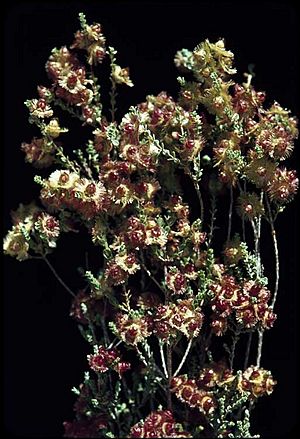Verticordia dichroma facts for kids
Quick facts for kids Verticordia dichroma |
|
|---|---|
 |
|
| Verticordia dichroma var. syntoma | |
| Scientific classification | |
| Genus: |
Verticordia
|
| Species: |
dichroma
|
Verticordia dichroma is a beautiful flowering plant that belongs to the Myrtaceae family, which is also known as the myrtle family. This plant is special because it is endemic to the south-west part of Western Australia. This means it only grows naturally in that specific area. It's a bushy plant with many branches, round leaves, and lovely, scented flowers that are deep red and golden.
About This Plant
Verticordia dichroma is a shrub that can grow from about 0.3 m (1 ft) (about a foot) to 2 m (7 ft) (about 6.5 feet) tall. It usually has one or more stems coming from its base.
- Leaves: The leaves are shaped like an egg or are almost perfectly round. They are small, about 2–4 mm (0.08–0.2 in) long. Sometimes, their edges are a bit jagged or "toothed."
- Flowers: The flowers have a nice smell. They grow in groups that look like spikes on straight stems. These stems are about 1.5–2 mm (0.06–0.08 in) long. All the flowers in a group tend to open at the same time.
- Flower Parts:
- The base of the flower, called the floral cup, is shaped like a top and is about 3 mm (0.1 in) long. It has 5 ridges and is smooth and hairless.
- The sepals, which are like small leaves that protect the flower bud, are deep red. Some are deep red with yellow parts. They are about 4–5.6 mm (0.16–0.22 in) long and have 10 to 12 feathery parts.
- The petals are golden-yellow with red spots. They are egg-shaped, about 5–7 mm (0.2–0.3 in) long, and about 2.5 mm (0.1 in) wide. They have a fringe (like a decorative border) that is about 1.5–2.5 mm (0.06–0.1 in) long and ear-shaped parts that are deeply divided.
- The style, which is part of the flower's reproductive system, is about 6 mm (0.2 in) long. It is bent and has long hairs on its sides.
- Flowering Time: You can see these beautiful flowers blooming from late October to December.
Naming This Plant
The scientific name Verticordia dichroma was first officially described by a scientist named Alex George in 1991. His description was published in a scientific journal called Nuytsia.
- Where it was found: The first samples of this plant were collected by Alex and Elizabeth George. They found them "west of the North West Coastal Highway, north of No.8 Tank," which is about 62 km (40 mi) north of the Kalbarri turnoff.
- Meaning of the name: The second part of the name, dichroma, comes from two Greek words: di- meaning "two-" and chroma meaning "colour." This name was chosen because the flowers have two main colours, deep red and golden, when they first open.
- Different Types: Alex George also described two different types, or varieties, of Verticordia dichroma:
- Verticordia dichroma var. dichroma: This variety has leaves that are 3–4 mm (0.1–0.2 in) long. Its sepals are 5–6 mm (0.20–0.24 in) long, and its petals are 6–7 mm (0.2–0.3 in) long. It also has groups of 12 or more flowers.
- Verticordia dichroma var. syntoma: This variety has shorter leaves, sepals, and petals compared to the dichroma variety. It also has fewer flowers in each group.
Where It Grows
Both varieties of Verticordia dichroma grow in deep sand. They often grow alongside other Verticordia plants in areas called heath and shrubland.
- Variety dichroma: This type is found in the eastern part of Kalbarri National Park. It also grows north towards Shark Bay and south to near Northampton. These areas are part of the Carnarvon, Geraldton Sandplains, and Yalgoo biogeographic regions.
- Variety syntoma: This type grows between the lower Murchison River and Shark Bay. It is found in the same biogeographic regions as the dichroma variety.
Conservation Status
Both varieties of Verticordia dichroma are listed as "Priority Three" by the Western Australian Government's Department of Parks and Wildlife.
- What "Priority Three" means: This classification means that scientists don't know a lot about these plants yet. They are only found in a few places. However, they are not currently in immediate danger of disappearing.
Growing This Plant
Both varieties of Verticordia dichroma are great for planting in gardens because their flowers are so amazing to look at.
- How easy it is to grow: It can be tricky to start new plants from cuttings (small pieces of the plant). But once they are planted and start to grow, they are very strong and hardy plants.
- Where it grows best: It is more difficult to grow these plants in eastern Australia compared to Western Australia.

